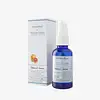What's inside
What's inside
 Key Ingredients
Key Ingredients

 Benefits
Benefits

 Concerns
Concerns

 Ingredients Side-by-side
Ingredients Side-by-side

Water
Skin ConditioningNiacinamide
SmoothingButylene Glycol
HumectantPropylene Glycol
HumectantPEG/PPG-14/7 Dimethyl Ether
Skin ConditioningCentella Asiatica Extract
CleansingGentiana Scabra Root Extract
Skin ConditioningAvena Sativa Kernel Extract
AbrasiveYeast Extract
Skin ConditioningCrocus Sativus Flower Extract
MaskingAlpha-Arbutin
AntioxidantCeramide NP
Skin ConditioningAvena Sativa Kernel Oil
Skin ConditioningSphingolipids
EmollientCeramide As
Skin ConditioningCeramide AP
Skin ConditioningCeramide Ns
Skin ConditioningCeramide Ng
Skin Conditioning1,2-Hexanediol
Skin ConditioningBis-PEG-18 Methyl Ether Dimethyl Silane
EmollientSodium Polyacryloyldimethyl Taurate
Emulsion StabilisingAllantoin
Skin ConditioningHydrogenated Lecithin
EmulsifyingAcrylates/C10-30 Alkyl Acrylate Crosspolymer
Emulsion StabilisingPentylene Glycol
Skin ConditioningIsohexadecane
EmollientTranexamic Acid
AstringentFructose
HumectantAminomethyl Propanol
BufferingPropanediol
SolventSodium Hyaluronate
HumectantDisodium EDTA
PEG-7 Glyceryl Cocoate
EmulsifyingPhosphatidylcholine
EmulsifyingPhytosterols
Skin ConditioningSodium Stearoyl Glutamate
CleansingHydroxyacetophenone
AntioxidantParfum
MaskingCaprylhydroxamic Acid
Soy Amino Acids
Skin ConditioningPhenoxyethanol
PreservativeChlorphenesin
AntimicrobialEthylhexylglycerin
Skin ConditioningWater, Niacinamide, Butylene Glycol, Propylene Glycol, PEG/PPG-14/7 Dimethyl Ether, Centella Asiatica Extract, Gentiana Scabra Root Extract, Avena Sativa Kernel Extract, Yeast Extract, Crocus Sativus Flower Extract, Alpha-Arbutin, Ceramide NP, Avena Sativa Kernel Oil, Sphingolipids, Ceramide As, Ceramide AP, Ceramide Ns, Ceramide Ng, 1,2-Hexanediol, Bis-PEG-18 Methyl Ether Dimethyl Silane, Sodium Polyacryloyldimethyl Taurate, Allantoin, Hydrogenated Lecithin, Acrylates/C10-30 Alkyl Acrylate Crosspolymer, Pentylene Glycol, Isohexadecane, Tranexamic Acid, Fructose, Aminomethyl Propanol, Propanediol, Sodium Hyaluronate, Disodium EDTA, PEG-7 Glyceryl Cocoate, Phosphatidylcholine, Phytosterols, Sodium Stearoyl Glutamate, Hydroxyacetophenone, Parfum, Caprylhydroxamic Acid, Soy Amino Acids, Phenoxyethanol, Chlorphenesin, Ethylhexylglycerin
Water
Skin ConditioningPropylene Glycol
Humectant3-O-Ethyl Ascorbic Acid
Skin ConditioningHydroxyethylcellulose
Emulsion StabilisingSalicylic Acid
MaskingAlcohol
AntimicrobialTocopheryl Acetate
AntioxidantAmylopectin
Dextrin
AbsorbentXanthan Gum
EmulsifyingDMDM Hydantoin
PreservativeTetrasodium EDTA
Tranexamic Acid
AstringentSodium Hyaluronate
HumectantParfum
MaskingButylene Glycol
HumectantIodopropynyl Butylcarbamate
Preservative
 Reviews
Reviews

Ingredients Explained
These ingredients are found in both products.
Ingredients higher up in an ingredient list are typically present in a larger amount.
Butylene Glycol (or BG) is used within cosmetic products for a few different reasons:
Overall, Butylene Glycol is a safe and well-rounded ingredient that works well with other ingredients.
Though this ingredient works well with most skin types, some people with sensitive skin may experience a reaction such as allergic rashes, closed comedones, or itchiness.
Learn more about Butylene GlycolParfum is a catch-all term for an ingredient or more that is used to give a scent to products.
Also called "fragrance", this ingredient can be a blend of hundreds of chemicals or plant oils. This means every product with "fragrance" or "parfum" in the ingredients list is a different mixture.
For instance, Habanolide is a proprietary trade name for a specific aroma chemical. When used as a fragrance ingredient in cosmetics, most aroma chemicals fall under the broad labeling category of “FRAGRANCE” or “PARFUM” according to EU and US regulations.
The term 'parfum' or 'fragrance' is not regulated in many countries. In many cases, it is up to the brand to define this term.
For instance, many brands choose to label themselves as "fragrance-free" because they are not using synthetic fragrances. However, their products may still contain ingredients such as essential oils that are considered a fragrance by INCI standards.
One example is Calendula flower extract. Calendula is an essential oil that still imparts a scent or 'fragrance'.
Depending on the blend, the ingredients in the mixture can cause allergies and sensitivities on the skin. Some ingredients that are known EU allergens include linalool and citronellol.
Parfum can also be used to mask or cover an unpleasant scent.
The bottom line is: not all fragrances/parfum/ingredients are created equally. If you are worried about fragrances, we recommend taking a closer look at an ingredient. And of course, we always recommend speaking with a professional.
Learn more about ParfumPropylene Glycol is an odorless, colorless liquid. As a humectant, it helps skin retain moisture. It also aids in delivering active ingredients.
Another role of this ingredient is preventing a product from melting or freezing. Propylene glycol also adds antimicrobrial properties to a product, elongating product lifespan.
This ingredient is considered an organic alcohol and commonly added into both cosmetics and foods.
Those with sensitive skin or conditions may develop a rash when using this ingredient.
Learn more about Propylene GlycolSodium Hyaluronate is hyaluronic acid's salt form. It is commonly derived from the sodium salt of hyaluronic acid.
Like hyaluronic acid, it is great at holding water and acts as a humectant. This makes it a great skin hydrating ingredient.
Sodium Hyaluronate is naturally occurring in our bodies and is mostly found in eye fluid and joints.
These are some other common types of Hyaluronic Acid:
Learn more about Sodium HyaluronateTranexamic Acid is best used for treating hyperpigmentation, discoloration, and melasma. It can also help build a stronger skin barrier.
Once applied, Tranexamic Acid starts decreasing inflammation from UV exposure. Tranexamic Acid also prevents our skin cells from meeting the pigment production cells.
Its brightening property makes it great at reducing the appearance of acne scars and marks.
Fun fact: Tranexamic Acid is also a medication used to reduce heavy bleeding.
This acid is derived from lysine, an amino acid.
Learn more about Tranexamic AcidWater. It's the most common cosmetic ingredient of all. You'll usually see it at the top of ingredient lists, meaning that it makes up the largest part of the product.
So why is it so popular? Water most often acts as a solvent - this means that it helps dissolve other ingredients into the formulation.
You'll also recognize water as that liquid we all need to stay alive. If you see this, drink a glass of water. Stay hydrated!
Learn more about Water